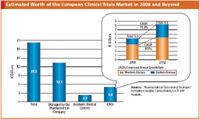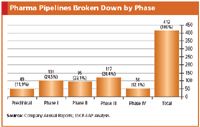Emerging Market Trends from Europe
Survey uncovers current market and future directions for the European clinical trials industry.
The European clinical trials market in 2008 is estimated to be around €20.3 billion ($32 billion). If the forecasted revenue growth of CROs is a good indicator, we can expect the market to grow by 10.6% annually, reaching €30.38 billion ($47 billion) in 2012, with growth notably coming from the Eastern part of Europe (see Figure 1). A key driving force behind this strong growth is the increasing number of drugs that need to be tested, as pharma companies are complimenting the traditional model of developing blockbusters with greater emphasis on niche drugs.1 Our interviews also validated an estimate that in value terms, some 65% of clinical trials are directly managed by pharmaceutical companies, whilst CROs account for most of the remaining 35%.

PHOTOGRAPHY: GETTY IMAGES ILLUSTRATION: PAUL A. BELCI
A cursory inspection of the pipeline of five major pharmaceutical companies reveals that more than half of all drugs under development are in Phases II and III of clinical trials (see Figure 2). This suggests that there will be continued growth in the size of the Phase III market, in which the trials are often the largest and have a greater demand for service provision. It also seems likely that at least one third of these will be for trials of new molecular entities.2

Figure 1. A breakdown of the European market for clinical trials by key players in 2008 and a growth forecast for the years 2008 to 2012 for Western and Eastern Europe.
We also assessed the cost of clinical trials. It is obvious that such breakdowns vary greatly from one trial to another. But from our interviews with the different players in the market, we have established that the most expensive category of the clinical trial is salaries and wages to doctors, nurses, and technicians at the investigational sites (see Table 1). Next come the CROs (or their activities), which account for a quarter to one third of the cost. Trial and comparator drugs make up of for some 10% to 20% of the total cost, while another 10% to 20% goes to shipping and handling of drugs and trial kits (usually when cold-chain is required, the proportion of logistics will increase to 30% of the cost). Furthermore, we found that the cost of comparator drugs and placebos (including packaging, recapsulation, and labeling) cost half as much as the drugs to be trialed. These categories are not mutually exclusive, but offer a broadly validated basis for estimation.

Figure 2. Number of drugs in the pipeline according to phase for five leading pharmaceutical companies as of early 2008: AstraZeneca, GlaxoSmithKline, Pfizer, Roche, and Sanofi-Aventis.
Regulatory harmonization
In 2001, the EU published the EU Clinical Trials Directive, which aims at harmonizing national regulatory frameworks. The key impact of the Directive is that every member state became responsible for creating separate regulations that transpose the Directive into national law. It also saw the establishment of the EudraCT, a database of all interventional clinical trials of investigational medicinal products in the EU. [At the time of our research, this database had yet to begin operations.]

Table 1: Breakdown of clinical trial costs.
But some of the key outcomes of the Directive are already in place, including that labels must be in the local language (although the labeling system has been harmonized); the standardization of application forms; and the introduction of free movement of materials between the United States or Japan and Central and Eastern Europe (CEE). And it is now illegal to start a clinical trial unless an ethics committee has consented, the MHRA has licensed the trial, and the sponsor has been declared.
This, however, does not necessarily mean that conducting clinical trials in Europe is easier than before. Despite the attempt to create a unified clinical trial regulatory framework throughout the EU, there remains differences in practice. One company that exports abroad told us that there are still headaches regarding import licenses for Eastern Europe, but these problems are decreasing. For instance, Poland still requires the submission of a signed contract, whereas usually a template is sufficient in other countries. Such local variations inevitably demand more corporate resources.
Furthermore, the regulatory framework put forward by the EU is often far more rigorous than national ones. Consequently, as we discovered in our interviews with companies, the Europe-wide implementation of the Directive has inevitably made conducting clinical trials a more costly exercise in terms of time and financial investment. But despite these obstacles, companies generally subscribe to the view that the ever-increasing degree of harmonization will ultimately make it easier for them to engage in clinical trials.
There seems to be a degree of consensus throughout the clinical trial industry on two points. One, that there is an increased emphasis on niche drugs, and therefore clinical trials require specialist centers that have expertise in the specific clinical area. And two, that the increase in the variety of drugs in trials creates demand for a wider opinion leader base, and the expansion of the EU gives rise to multicenter clinical trials that are conducted in multiple countries.

Creation of Hybrid Logistics Models
These two issues create a larger role for logistics companies to coordinate between multicenter sites and expand the complexity of conducting a clinical trial. We found evidence that the industry structure is making a corresponding change. For example, Quintiles used to operate as a one-stop shop; however, the increasing complexity of the underlying market meant that sponsors had to deal with different people at each step. This undermined the point of only having to deal with one company. So, they've since sold off their packaging division and moved away from this model. Pfizer also depends on outsourcing, having downsized its in-house capabilities.
While the clinical trial industry is constantly reforming itself, we have identified three main trends:
- An expansion of clinical trials into new markets in CEE
- Increasingly complex services provided by discrete units in the clinical trial value chain
- Entirely new hybrid logistics business model that provides linkages between the entire value chain.
New markets
One doesn't need to travel to Eastern Europe to detect the emerging trend of the region. According to a company based entirely in the UK, the proportions of the materials that they package that remain in the UK are "tiny." Roughly 50% are shipped elsewhere in Europe and 50% to the rest of world.
In terms of breaking down the EU market into separate areas, this is problematic for several reasons. Many of the major CROs are U.S.-based and only consider global trends since business units define revenue in different ways (making it hard to compare like with like). And if they are a public company, their attention is on the share price, which is a global value. Also, since trials span multiple countries, there is no meaningful difference in growth rates throughout each region—that is, we can infer the Czech growth rate from CEE, given the population size and therefore availability of patients.
The growth drivers for clinical trials in CEE are greater access to drug-naïve patients, lower labor costs and other site fees, higher concentration of patients near sites, and closer relationships between doctors and patients. All this creates a typical dropout rate of less than 5% compared to 20% in Western Europe. This means that the initial investment to start a trial, such as the submission fees to ethic committees, give access to a much higher number of potential subjects suitable for the trial than in Western Europe—consequently, CEE offers more subjects per Euro spent.
It is important to appreciate the role of CROs as drivers into these new markets. Although they cannot directly recruit patients, they can drive the enrollment and retention in two ways. Firstly, CROs can help sites in the preselection of potential study subjects since they have their own databases of potential recruits. Secondly, the CRO helps the preselected subjects by offering them training courses on the trial, vocabulary related to it, questions to ask doctors, and information on their rights to reduce the time to informed consent. Furthermore the CRO can "brand" the study by providing materials to subjects, such as calendars, mouse pads, pens, folders with documentation—and these techniques have higher success rates than in Western Europe or North America. This improves subject retention and speeds up the overall process.

Survey and Article Methods
Thus, the geographical reach of CROs (plus the lack of capacity to maintain the services they offer) is driving expansion into CEE. One global CRO told us that Poland was the "first and most obvious place" to begin its CEE operations. A separate supplier confirmed that for companies with operations in Eastern Europe, "almost all would have a presence in Poland." In terms of growth, our understanding is that CEE is growing at about twice the rate of Western Europe—some companies interviewed use 30% vs. 10% as their assumption.
According to one company based in Prague, about 500 trials are approved each year in the Czech Republic. The country is particularly attractive because every Czech citizen has mandatory health insurance, there is one doctor for every 3.48 patients, there are 78 medical research universities, and new companies setting up in Czech receive tax relief for 10 years (and can deduct all R&D costs conducted within the country).
Finally, it's important to discuss Russia. The main reason why Russia is distinct from the rest of Europe is that as a non-EU country there are customs requirements that forbid direct shipments to the investigational sites (such as the need for import and export licenses). To create economies of scale and reduce the lead time for paperwork this creates a need for subdepots/warehousing, which can approach 40% of the cost of the logistics for a clinical trial. In addition, some interviewees refer to "unpredictable" elements in the approval process.
Rising complexities
CROs are often perceived as a one-stop shop for clinical trials. While small pharma companies and biotechs generally lack the ability to conduct their own full-scale trials, large companies possess the capability to undertake trials in house. Hence, major pharmaceuticals will mainly employ CROs when they run out of capacity or require access to previously untapped investigational sites. To larger sponsors, the CRO is seen as a service provider, and in some instances there will be little direct involvement from the sponsor for the duration of the trial.
Pharmaceutical companies, however, are likely to always retain two activities: protocol development and site monitoring. Protocol development has significant legal implications and outsourcing it may lead to many potential problems. Whereas with the latter activity (i.e., site monitoring), direct contact with investigators and sites is the only way that the company can capture the knowledge generated at the sites.
CROs already provided preclinical and clinical trial services, but they are now expanding into broader service provisions:
- Preclinical testing: preclinical safety evaluation, study design, product development
- Project management: taking responsibility for project management throughout the clinical trial process rather than specific phases
- Sponsor networking: services to provide sponsors for niche projects, such as conferences and other networking events
- Regulatory consulting: ensuring regulatory compliance for a broad area of legislative issues and post-trial approval phase
- Analysis and reports: data collection, statistical analysis, production of results, and reporting to sponsors.
Other players in the clinical trials industry are also evolving. For example, clinical suppliers are gradually moving beyond their traditional activities of packaging, labeling (in local languages), storing, distributing, and reconciling drugs and kits to also include associated equipment, instrumentation, and associated drugs. Currently, the main activities account for 80% to 90% of business. Clinical suppliers also face challenges in expanding their business in emerging markets.
An important player that has received relatively little attention is drug wholesalers—the suppliers of comparator drugs for clinical trials. Sponsors usually have to go through these wholesalers to source drugs for comparison. The alternative is to obtain comparators directly from market rivals and risk signaling to them that they are testing a competitive product. Hence, drug wholesalers play a vital role as a third-party dealer by allowing the sponsor to remain confidential.
There is an industry trend toward the outsourcing of packaging and labeling—which we believe currently stands at over 90% of trials—resulting in very little premium logistic requirements to move drugs from manufacturer to trial site. The main capabilities required by these new entrants are knowledge of labeling requirements (an ability to design and produce labels adhering to EU and local regulations [including translation], special marking to distinguish from nonclinical trial packages, releafleting, etc.); the ability to repackage materials and prepare kits, including the expertise to alter the composition of the drug to ensure blinding via recapsulation; and splitting shipments into smaller quantities and creation of kits.
The main conclusion is that the risks associated with clinical trials are rising, as is the global reach. We've identified three key emerging trends: increases in activity in CEE, more complex services provided throughout the value chain, and the emergence of hybrid logistics providers. We are not claiming that the information we have provided is definitive; however, the absence of usable figures means that even tentative estimates can be useful for corporate decision-making.
Anthony J. Evans,* PhD, is assistant professor of economics and Terence Tse, PhD, is assistant professor of finance at ESCP-EAP European School of Management, 527 Finchley Road, Hampstead, London NW3 7BG, email: aevans@escp-eap.net
*To whom all correspondence should be addressed.
References
1. The Compound Annual Growth Rate of total blockbuster sales was forecast to be 1.6% from 2005 to 2008, compared to the 9% growth seen in 2002 to 2005. See "Beyond the Blockbuster Drug," Business Insights, February 2005, www.piribo.com/publications/drug_delivery/beyond_blockbuster_drug.html.
2. "Changing Patterns of Pharmaceutical Innovation," National Institute for Health Care Management, Washington, DC, May 2002, www.nihcm.org/~nihcmor/pdf/innovations.pdf.
3. Source: company website: www.worldcourier.com/Global/indexHome6CTMmenu.html

FDA Fast Tracks Johnson & Johnson’s Nipocalimab for Fetal Neonatal Alloimmune Thrombocytopenia
March 27th 2024Johnson & Johnson is moving forward with a pair of Phase III trials of nipocalimab to reduce the risk of fetal neonatal alloimmune thrombocytopenia in alloimmunized pregnant patients.